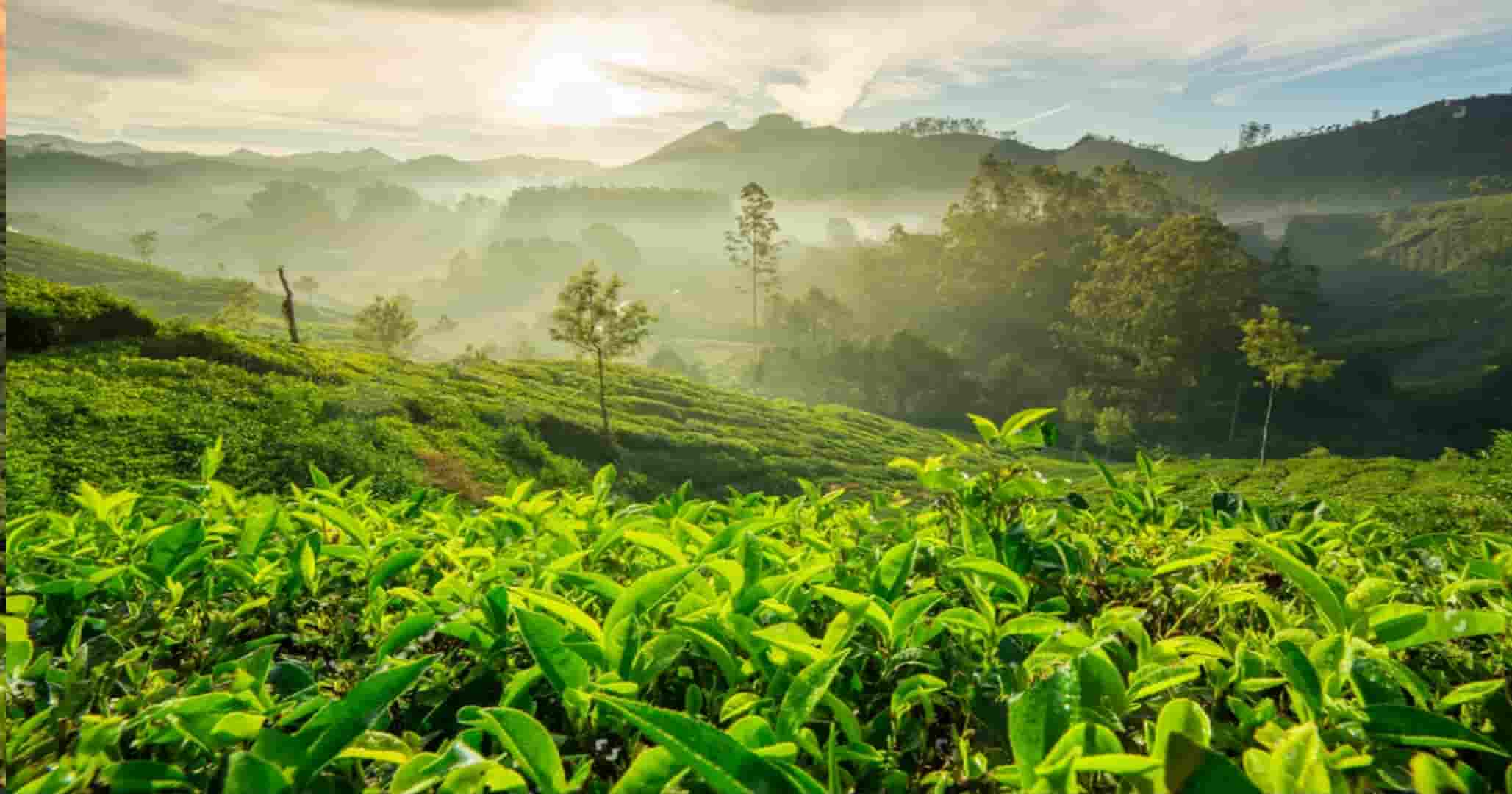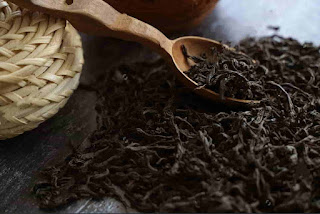This article describes what is the Indian legend regarding the discovery of tea, about modern tea production in India, about the government and the Indian tea industry, and about tea in Indian popular culture.
 |
| Sunrise Over Tea Plantations in Munnar |
 |
| Indian tea with tea leaves and wooden spoon on dark wooden background |
What is the Indian Legend Regarding the Discovery of Tea?
The Indian legend regarding the discovery of tea involves a historical figure named Bodhidharma, who was an ancient Buddhist monk and the founder of the Zen tradition of Buddhism. According to the legend, Bodhidharma traveled from India to China around the 5th or 6th century CE.
During his journey, Bodhidharma was said to have become overwhelmed by drowsiness while meditating. To combat his fatigue and to remain alert during his long hours of meditation, he decided to pluck a few leaves from a nearby plant and chew on them. The plant happened to be a wild tea tree.
As he chewed on the tea leaves, Bodhidharma experienced a revitalizing effect and found his drowsiness fading away. He was amazed by the properties of the tea leaves and recognized their potential to aid in meditation and promote wakefulness.
Inspired by this discovery, Bodhidharma continued his journey to China and eventually settled in the Shaolin Temple. He introduced the practice of tea consumption to the monks there, emphasizing its benefits for meditation, focus, and overall well-being.
This legend highlights Bodhidharma's role as a key figure in the spread of both Buddhism and tea cultivation throughout China and, eventually, other parts of the world. Tea has since become deeply rooted in various cultures, including India, China, Japan, and many other countries, and is renowned for its diverse flavors and health benefits.
Modern Tea Production in India
Modern tea production in India is a significant industry and plays a crucial role in the country's economy. Here are some key aspects of modern tea production in India:
Geographic Distribution: Tea cultivation in India is primarily concentrated in the northeastern states and the foothills of the Himalayas. The major tea-producing regions include Assam, Darjeeling, Dooars-Terai, Nilgiris, and Kangra. Each region has its unique climate, soil conditions, and elevation, leading to the production of different types and flavors of tea.
Varieties of Tea: India is known for producing a wide range of teas, including black, green, white, oolong, and specialty teas. Assam tea is renowned for its robust and malty flavor and is primarily used for black tea production. Darjeeling tea, grown in the hilly region of West Bengal, is famous for its delicate aroma and muscatel flavor, often referred to as the "Champagne of teas." The Nilgiris in southern India produce teas with a mellow and fragrant character.
Tea Estates and Smallholder Farms: Tea production in India involves both large-scale tea estates and smallholder farms. Large tea estates often cover vast areas and have tea factories on-site for processing. Smallholder farms, on the other hand, are usually family-owned and cultivate tea on smaller plots of land. These farms supply tea leaves to tea factories for processing.
Processing: After the tea leaves are plucked, they undergo a series of processing steps. For black tea, the leaves are withered, rolled, fermented, and dried. Green tea goes through minimal oxidation and is pan-fired or steamed to preserve its natural color and flavors. White tea is made from young tea buds and undergoes minimal processing. Oolong tea is partially oxidized, resulting in a range of flavors and aromas.
Organic and Specialty Teas: India is also known for its production of organic teas. Several tea estates and small farms follow organic farming practices, avoiding the use of synthetic fertilizers and pesticides. Specialty teas, such as organic, single-origin, handcrafted, and rare teas, have gained popularity among tea connoisseurs globally. Darjeeling and Assam produce some highly sought-after specialty teas.
Tea Auctions and Export: Tea auctions are an important part of the Indian tea industry. Auction centers like Kolkata, Guwahati, and Coonoor facilitate the sale of bulk teas, with buyers bidding for various grades and qualities. India is one of the largest exporters of tea in the world, supplying tea to countries in Europe, North America, the Middle East, and Asia. Indian tea is known for its quality, diversity, and distinct regional flavors.
Social and Labor Practices: The tea industry in India faces challenges related to labor rights and fair wages. Efforts are being made to improve social conditions, ensure fair wages, and promote sustainable practices through certifications like Fair Trade and Rainforest Alliance.
Overall, modern tea production in India encompasses a rich diversity of teas, with a blend of traditional and contemporary practices. Indian tea continues to be a significant player in the global tea market, appreciated for its unique flavors and cultural heritage.
Government and the Indian Tea Industry
The Indian tea industry is closely linked with the government, as it plays a significant role in regulating and supporting the sector. Here are some key aspects of the government's involvement in the Indian tea industry:
Ministry of Commerce and Industry: The Ministry of Commerce and Industry, through its Department of Commerce, is responsible for formulating and implementing policies related to the tea industry. It focuses on promoting tea exports, market development, trade facilitation, and addressing industry-related issues.
Tea Board of India: The Tea Board of India is a statutory body under the Ministry of Commerce and Industry. It serves as the apex regulatory authority for the Indian tea industry. The board's functions include regulating tea cultivation, processing, and marketing, ensuring quality standards, promoting exports, conducting research, and providing financial assistance to the industry.
Regulatory Framework: The government has established regulations and standards to ensure the quality and safety of Indian tea. The Tea Board sets guidelines and monitors compliance with these standards, covering aspects such as cultivation practices, manufacturing processes, packaging, labeling, and export requirements.
Research and Development: The government supports research and development initiatives in the tea industry. Organizations like the Tea Research Association (TRA) and the Tea Research Institute (TRI) conduct scientific research, develop new tea varieties, improve cultivation techniques, and address challenges faced by tea growers.
Financial Assistance and Subsidies: The government provides financial assistance and subsidies to tea growers and processors to promote the industry's growth and competitiveness. These schemes include subsidies for replantation, rejuvenation of old tea bushes, mechanization, irrigation, and infrastructure development.
Promotion of Indian Tea: The government actively promotes Indian tea both domestically and internationally. It participates in trade fairs, exhibitions, and buyer-seller meets to showcase Indian teas and facilitate business interactions. The Tea Board undertakes marketing campaigns to raise awareness about Indian teas and support market development initiatives.
Labor Welfare: The government focuses on labor welfare and addresses labor-related issues in the tea industry. Various laws and regulations govern the working conditions, wages, social security, and welfare of tea estate workers. Efforts are being made to improve the living standards of workers, promote fair wages, and ensure better healthcare and educational facilities.
Export Promotion: The government encourages tea exports and provides support to exporters. It offers export incentives, facilitates market access through trade agreements and negotiations, provides market intelligence, and organizes trade delegations to target markets. Export promotion councils work closely with the government to boost tea exports.
In Popular Culture
Tea holds a significant place in popular culture around the world, including in India. Here are a few examples of how tea is portrayed in popular culture:
Bollywood Movies: Indian cinema, particularly Bollywood, often features scenes set in tea gardens or tea stalls. Tea breaks and conversations over a cup of tea are commonly depicted, representing social interactions, romance, or moments of reflection in films. Tea is often used as a symbol of hospitality, warmth, and comfort.
Chai Culture: In India, the term "chai" refers to tea, specifically the spiced and sweetened milk tea commonly consumed across the country. Chai is deeply ingrained in Indian culture, and it is a daily ritual for many. It is depicted in movies, TV shows, and advertisements as a part of everyday life, showcasing people coming together to enjoy a cup of chai.
Advertising: Tea brands in India frequently use popular actors and celebrities in their advertisements to promote their products. These commercials often highlight the refreshing and rejuvenating aspects of tea, portraying it as a source of energy, relaxation, or a companion during moments of solitude.
Literature and Poetry: Tea has been featured in Indian literature and poetry, both traditional and contemporary. Poets often use tea as a metaphor for various emotions, experiences, or the beauty of everyday life. Tea serves as a source of inspiration and symbolism in literary works, reflecting the cultural significance of the beverage.
Art and Design: Tea motifs and imagery can be found in Indian art and design. Tea sets, teapots, and teacups are often depicted in traditional and contemporary artwork, showcasing the aesthetic appeal and cultural value of tea.
Tea Tourism: In regions like Darjeeling, where tea plantations are a significant attraction, tea tourism has emerged as a popular niche. Travelers visit tea estates to experience the tea-making process, explore the scenic landscapes, and engage in tea tasting sessions. Tea tourism has become a way to promote local culture, heritage, and the natural beauty associated with tea cultivation.
These are just a few examples of how tea is represented in Indian popular culture. Tea's ubiquity and cultural significance make it a prominent element in various forms of artistic expression and daily life in India.





